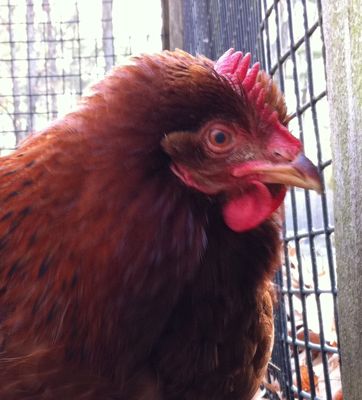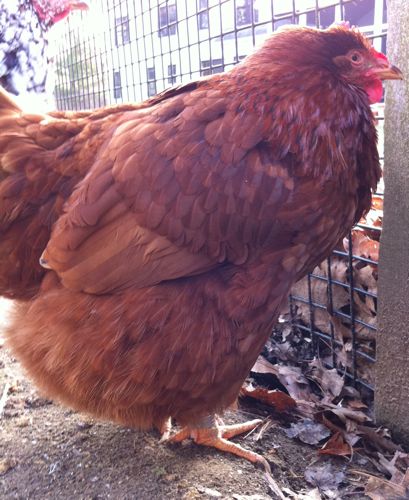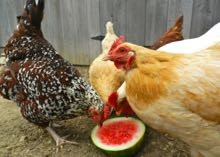When I go into the coop in the morning, all of the hens are on the floor, waiting at the pop door, eager to go out. All except Petunia. She is still on the top roost, fluffed up. Hopping up the roosts to her sleeping spot isn’t too hard, but getting down is difficult for this old hen. I pick her up and gently put her on the coop’s floor. She doesn’t hurry outside with the others. I worry.
Her eyes are bright. Her wattles red and flexible. Her feathers luxurious. She’s eating. But, her body language tells me that she is uncomfortable. Possibly not here for much longer.
See how she holds her shoulders hunched? And how her bottom is low to the ground? And, she is facing out, with her back to the other hens. That’s a protective stance. Old hens get arthritis and tumors, cancer and liver disease. Their ovaries become enlarged. I don’t know what’s going on inside of Petunia. She doesn’t have a fearful look in her eye that animals in pain have. Eleanor, the barred rock in the big barn, has been walking around like this, old and creaky and slow, for over a year. Somehow, though, I think that Petunia is not going to be able to keep going.
Petunia is one of twenty-five chicks that a friend got in a shipment from Murray McMurray Hatchery. They hatched on October 6, 2004. I got five chicks from her a few weeks later. Amazingly, three remain. Ginger, who laid beautiful blue eggs, died two years ago. Cause unknown. Petunia’s sister New Hampshire Red, Marge, died this past summer after a week of internal laying. Maybe that’s Petunia’s problem, too.
Six is old, really old, for a hen. I’ll do my best to keep Petunia and the other elderly residents comfortable. But, I expect losses this winter. I’ll miss these old birds that I’ve gotten to know so well, but it’s okay. It’s what happens. I’m planning on getting chicks in the spring. I’m looking forward to that. And, who knows, maybe these old hens will keep on going. Eleanor and Buffy have certainly surprised me. I was sure that neither would make it through last winter and here they are!
It’s a lovely day. I think I’ll let the old girls out for a walk around a sun bath in the leaves.



My own hens are reaching the three year mark. Last month, I found one barred rock “spatchcocked” on the coop floor. She was unable to use either leg. I put her temporarily into a small cage, water and food nearby. Next morning, she was very hungry. I put some Vit D and calcium in her water, gave her sunflower seeds and corn and protein. A few days later, she was pushing herself into a sitting position, crouched on both feet. Two days ago, after a month healing, she went out into the flock. She limps a bit, but is so happy I gave her a chance. I doubt she will lay again, and still don’t know what happened…maybe muscles gave out when she landed off the roost. I will get more chicks this spring, too. And the others are retired for as long as they are comfortable. They gave me too many eggs and so much entertaiment to do otherwise.
My Buffy also lost the ability to walk. I nursed her back to health. Took a month. It’s been two years and she hasn’t laid an egg, but she looks fine! However, Petunia has different symptoms. Not good, but hens have a remarkable ability to keep ticking, so I’m not writing her off yet.
Yes Terry that stance is never a good sign. At her age I wouldn’t think she would be egg bound or an internal laying issue. I suspect you checked for an egg stuck in the laying canal.
I like you suspect cancer or some other organ disease.
OT, I made turkey bone soup with the turkey carcas this past weekend, it was good and what a great use of all that dark meat no one seems to eat.
I’d be surprised if she was an internal layer, but all signs point to it. Swollen, soft abdomen. Feels like a water balloon. Discomfort moving, but still has an appetite. Still producing manure, so nothing is stuck in there. The hen I know was an internal layer had shell-less eggs in the body cavity – she was past laying age, too.
Some hen owners I know have drained the fluid from a bird’s abdomen to make them comfortable – there can be quite a bit in there and as you say can be from egg peritonitis. I think also the ascites risk is quite high in older birds, they seem to have odd little cancers popping up for no real reason and I still think it was some form of leukosis like that that did for my other two Dottes, but without a PM there’s no hope of knowing. Fingers crossed.
But I can’t imagine opening them up, saved the hens. My understanding is that once they start building up fluid from eggs in the abdominal cavity, that there’s no going back to normal laying. What have you heard?
In the instances I have heard of, the fluid was syringed out regularly, purely to reduce pressure on the other organs and make the bird more comfortable – I think some folk combine this with Baytril injections to contain any infection and apparently in some cases it does the trick nicely. For example I’m convinced that my Duck is an internal layer, but she’s clearly reabsorbing it all and in no danger until the process ceases to be sterile. She still lays normally occasionally. I wonder if in old hens (like in women!) there’s a tendency to hyper-ovulate as they get older (remember Duck’s five yolks in a sock?), and that this is what causes the problems, an extra volume of egg material in the cavity, rather than just one.
Do you think a human diuretic like Frusemide would help?
That’s interesting, using a syringe. But, caring for hens is a decision-making process on a continuum. If I were a farmer who needed my animals to provide income, she’d have been gone three years ago. If I didn’t take such good care of my animals, she’d likely be gone by now, as well. I’m willing to go extra lengths of doing the best animal husbandry I can, but I’m not going to go for the heroic measures. I don’t take my old birds to the vet. Partly it’s cost, and partly, to extend their lives another few months? Petunia has been fading for the last few months. I think that as a hen ages there are a myriad of issues, most unseen to us. Then, one becomes so serious that the hen can’t hide it anymore. When I did the post-mortem on Marge, not only was she an internal layer, with perionitis, but she also had a severely enlarged ovary and lesions. I’m going to leave her be, and let this run it’s course. She joined the other hens for a breakfast of leftover spaghetti. I think from her perspective, the quality of life is still okay!
Everything is better after pasta!
Oh dear, poor Petunia! She does look fed up, but as you say, her face is a good colour. The ‘not joining in’ always worries me more than anything. I find keeping them stimulated can sometimes snap them out of that moping and buck them up a bit, so I hope she enjoyed pottering in the sun. When Big Girl had her mystery illness I kept her with me in the garden as I planted bulbs and she perked considerably from having a job! She hits six in Spring, and I worry about her too.
She was happy to eat some grass, and then looked too tired to continue. I’m not optimistic, not with that hanging abdomen. But, I do think you’re right about keeping them up and about. When a hen gives up, she’s gone.
Hi Terry…I too know the issues with old hens and I am on the same page as you. If they look sick I will pull them out and put them in a separate cage away from the other birds and do the antibiotic routine. They usually perk up or pass. I just try to make their quality of life decent as long as they want me to. Please let us know where you order your new hens. I have always had good luck with Ideal in Texas (the birds are always alive and thrive when I get them)..but I wouldn’t mind trying something new? Last year they did throw in 2 roos (why do they do that?) and a runt that is half the size she is supposed to be, but bless her heart..she is just as bossy as they rest of them!
Donna, they do it for a couple of reasons. 1. if it’s cold when they ship they will throw in extra roos for extra warmth during the trip. 2. They do it because no one wants roos in the quantity they hatch and this prevents them from having to dispatch so many roos. (this is the reason I believe they do it).
When I place my order with the hatchery I always call it in and very nicely insist they do not give me extra chicks and they accomidate me. They almost always then throw in an extra pullet of one of the breeds I ordered.
Quick story, I had a aunt that lived near the Murray McMurray hatchery in Iowa, I would always plan a long weekend trip to Iowa to see her and would actually pick up my chicks in person. The folks in the front office (they won’t let you anywhere near the back, I tried)were very nice and I always would talk a while with them. I asked one day what actually happened to all the roos that no one wanted.
1. You don’t really want to know what happens to most. 2. They would actually give them away to local kids if they had reptiles that needed to eat. 3. Iowa State is not far and they would take quite a few for “acedemic purposes”. 4. Locals were given a huge discount if they would pick them up from the hatchery.
YIKES! Thank you Ken, I feel better that they are with me rather than with a reptile….Needless to say..the roos have a wonderful home here with me…I try to never have more than 2 (separate hens, separate coops.
I am dreading the day one of my chickens pass away. I also do not know what I am supposed to do with the body. Do you bury it and hope it doesn’t get dug up by another animal, or call animal control to come pick it up?
Gina- this is a good question. We bury our dead hens on the same little hillside where we’ve buried pet rabbits. Even most suburban backyards have a spot for old animals. In the winter, when the ground is frozen, it’s more difficult. We’ve put one old hen deep under a raised bed (the only bit of ground that could be spaded) and she was part of the earth by the next growing season. I’ve heard of people who have taken the birds to vets to be sent out for cremation. Some people simply put them in the trash, just as you would a turkey carcass after Thanksgiving. Sometimes there’s nowhere else to dispose of them. Animal control will not come and get a dead hen – and you’re likely to open a can of worms – once the state is notified of deceased birds, they might come looking for disease.
Hi Gina, I bury mine, but I have acreage and my man digs nice big deep holes so they don’t get dug up. I have a couple “special birds” and those get buried in the herb garden. It is a nasty and sobering job, but it has to be done…Not sure about animal control, they might come. Years ago when i first started doing birds, a pack of dogs broke into my coop and killed all of my birds and animal control did come because I sited the people for letting their dogs run wild.
Donna, calling animal control for killer dogs is one of the few times I’d get them involved!
Thanks Terry! And really good point about animal control!
In the UK it is, or always used to be, illegal to bury any livestock. Not sure you’re allowed to put them in the bin either! I always bury mine, and so does every hen keeper I know. I put them with about two feet of earth on top and have had no problems, although we don’t have quite the same scavengers here as you!
Last year a friend of mine buried her horse on her land which involved diggers and winches and lord knows what else – but he was 32 and she had had him for 20 years, so she couldn’t let him go.
In the past, carcasses had value. You’d feed the dogs, or the pigs. Dead horses were removed by the knackers and turned into useful products, from sofa stuffing to glue to dog food. Now, it’s an expensive problem of how to get rid of large deceased animals. I wonder if the no burial law that you’re referring to was because the animals weren’t buried deep enough. Your friend needed diggers and winches. Imagine doing that with shovels.
Hi Terry,
I love reading your blog and felt compelled to write after your most recent post. I recently became the owner of 7 bantam hens and can’t imagine life without them now. The thought of losing any of them …
Anyway, I just want to say that I hope Petunia picks up. :)
I believe (but am not certain) laws prohibiting burying animals may have something to do with the water table.